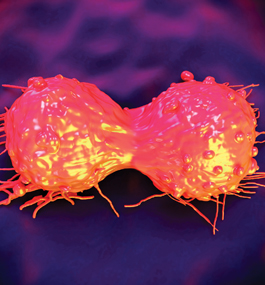A Tale of Two Proteins

iStock
MULTIPLICATION TEST: The drug Gleevec is able to stop reproducing cancer cells (like the one shown here) by binding with an enzyme that controls cell growth.
by Leah Burrows
Sometimes, it takes a billion years to solve a scientific puzzle.
Fortunately, biochemistry professor and Howard Hughes Medical Institute investigator Dorothee Kern has the patience required. She’s traced two proteins back through a billion years of evolution to pinpoint the precise evolutionary shifts that cause a cancer drug to bind well with one of the proteins and poorly with the other.
It’s a new approach to researching enzymes and their binding sites that may have a major impact on the development of rational drugs, which target specific biomolecules, to fight cancers.
Abl and Src are nearly identical protein enyzmes that cause cancer in humans, mainly chronic myeloid leukemia and colon cancer. The two proteins are separated by one big difference — Abl is susceptible to the cancer drug Gleevec; Src is not.
When Gleevec came on the market in 2001, it was hailed as a cancer-fighting magic bullet. Most cancer drugs wage a scorched-earth campaign, killing as many healthy cells as cancerous ones. But Gleevec is attracted only to Abl, the enzyme responsible for the growth and reproduction of cancer cells. Gleevec binds with Abl and deactivates it, stopping cancer in its tracks.
Scientists hoped to develop other drugs like Gleevec that could target specific enzymes in other types of cancer. Yet no one knew why Gleevec is so picky, willing to bind with Abl but not its close cousin Src.
To solve the mystery, Kern and her team rewound the evolutionary clock a billion years to find Abl and Src’s common ancestor, a primitive protein in yeast they dubbed ANC-AS. They mapped out the ANC-AS family tree, searching for changes in amino acids and molecular mechanisms.
“Src and Abl differ by 146 amino acids, and we were looking for the handful that dictate Gleevec specificity,” says Kern. “It was like finding a needle in a haystack and could only be done by our evolutionary approach.”
As ANC-AS evolved in more complex organisms, it began to specialize and branch into proteins with different regulation, roles and catalysis processes — creating Src and Abl. By following this progression, and testing the proteins’ affinity to Gleevec along the way, Kern and her team were able to whittle down the 146 different amino acids to the 15 responsible for Gleevec specificity. Their findings were published in the journal Science.
Now researchers have a jumping-off point for designing other drugs with a high affinity and specificity, and a strong binding point on cancerous proteins.
“Understanding the molecular basis for Gleevec specificity has opened wider the door to designing good drugs,” says Kern. “Our results pave the way for a different approach to rational drug design.”
